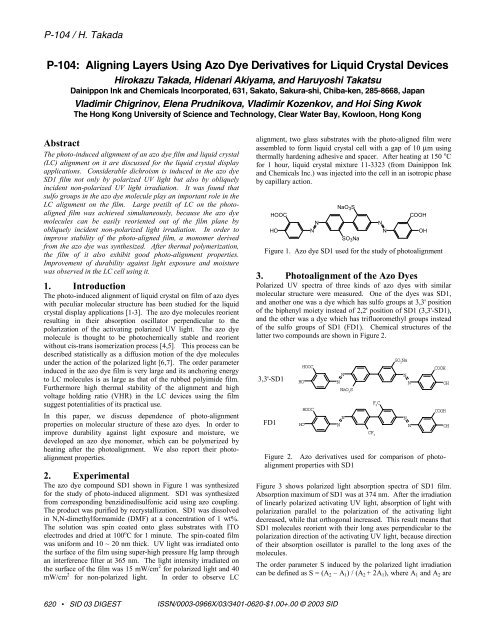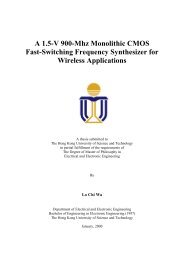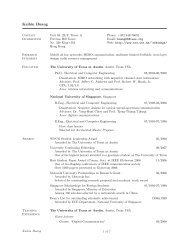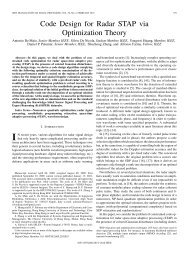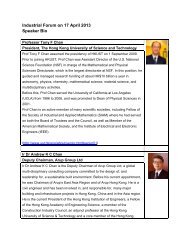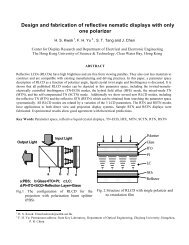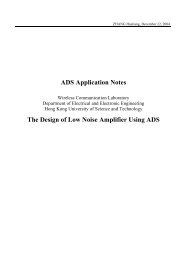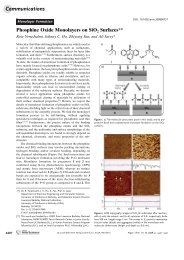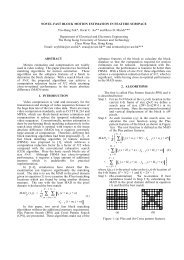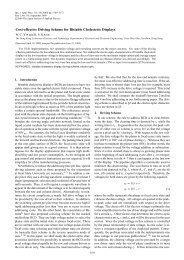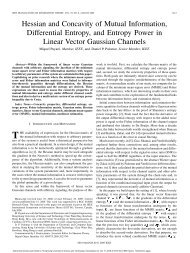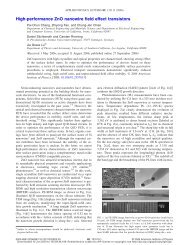Aligning Layers Using Azo Dye Derivatives for Liquid Crystal Devices
Aligning Layers Using Azo Dye Derivatives for Liquid Crystal Devices
Aligning Layers Using Azo Dye Derivatives for Liquid Crystal Devices
You also want an ePaper? Increase the reach of your titles
YUMPU automatically turns print PDFs into web optimized ePapers that Google loves.
P-104 / H. Takadamolecules are photoaligned with tilt from the plane by obliquelyincident non-polarized light irradiation.4. LC Alignment on the Photo-aligned<strong>Azo</strong> <strong>Dye</strong> FilmsLC alignment on the films of the azo dye derivatives wasobserved. In order to check the LC alignment directions, LCdoped with dichroic dye M-317 (from Dainippon Ink andChemicals Inc.) was injected into the cells. LC on the photoalignedSD1 and 3,3'-SD1 films were aligned perfectly andhomogeneously, while that on FD1 was aligned imperfectly. But,direction of the LC alignment is different between SD1 and 3,3'-SD1 film (see figure 6). <strong>Azo</strong> dye molecules in the all LC cellswere photoaligned in the direction marked in the figure. It isjudged from the figure that LC molecules on the SD1 films werealigned in parallel with the alignment direction of SD1 molecules,while those on 3,3'-SD1 films aligned perpendicularly, when UVlight was irradiated using methods (a) and (b). Alignment of LCon 3,3'-SD1 film was not uni<strong>for</strong>m in case of method (c).Large pretilt of LC on SD1 was achieved simultaneously byobliquely incident non-polarized UV light irradiation (see figure7). Considering the result of figure 5, it is deduced that pretilt ofLC is caused by out-of-plane reorientation of the azo dyemolecules.Pre-tilt angle (deg.)12108642Polarization directionof the polarizing films00 2 4 6Irradiated energy (J/cm 2 )3,3'-SD1Figure 7. Dependence of the pre-tilt angle on the irradiationenergy of the obliquely (45 o ) incident non-polarized lightSD1(a) (b) (c)1245°45°Upper side of the photograph5. <strong>Azo</strong> dye monomerThese photo-aligned azo dye molecules still have the ability toreorient by light irradiation unnecessarily. Besides, improvementof alignment durability against moisture is required, because theseazo dyes are soluble to water. In order to improve the durabilityagainst light exposure and moisture, polymerization of the azodyes after the photoalignment was investigated, synthesizing azodye monomer SDA1 shown in figure 8.OOOOHOOCNNSO 3 Na2Figure 6. Observation of LC alignment by the photo-alignedazo dyesThe cells injected with LC were placed between twopolarizing films. The UV irradiation methods used <strong>for</strong> thephotoalignment are shown under the photograph. <strong>Azo</strong> dyefilms of (a) and (c) are irradiated with obliquely incidentnon-polarized and vertically incident polarized UV light,respectively. Method (b) is polarized light irradiationfollowed by non-polarized light irradiation.From these results, it can be concluded that the LC alignment isstrongly influenced by the sulfo groups in these azo dyes, not bythe bis-azo structure.Figure 8. <strong>Azo</strong> dye monomer SDA1It was dissolved in DMF and doped by 0.02 % of thermalpolymerization initiator V-65 (<strong>for</strong>m Wako Pure ChemicalsIndustries, Ltd.). The mixture was spin-coated onto glasssubstrates and photoaligned in the same manner as SD1. After thephotoalignment, the SDA1 film was heated at 150 o C during 1 hour<strong>for</strong> the purpose of thermal polymerization.Optical anisotropy was also induced in the SDA-1 film by eitherpolarized or obliquely incident non-polarized light irradiation (seefigure 9). LC on the SDA1 film was aligned in the same directionas SD1. Pretilt of LC was achieved by the obliquely incident nonpolarizedlight irradiation, too.622 • SID 03 DIGEST
P-104 / H. TakadaImprovement of durability against light exposure in the LC cellusing SDA1 photo-aligned film after the thermal polymerizationwas confirmed. It can be concluded that LC alignment propertiesof the azo dye layer are preserved and the durability in thealignment is improved after the polymerization of SDA1.500 µmLC cellFigure 9. Polarized microscope photograph of LCalignment on photoaligned SDA1 film6. Conclusion<strong>Azo</strong> dye SD1 is photoaligned not only by linearly polarized lightbut also by obliquely incident non-polarized light irradiation. SD1molecules reorient with their long axes perpendicular to thepolarization direction of the polarized light, or parallel to theincidence plane of the obliquely incident non-polarized light. Butthe alignment of LC is influenced by the sulfo groups in SD1molecule, not by the oriented direction of the bis-azo structure.Pretilt of LC is caused by out-of-plane alignment of the SD1molecule induced by obliquely incident non-polarized UV lightirradiation.Alignment durability against light exposure and moisture can beimproved by polymerization of the azo dye monomer which hasthe same structure as SD1 in the molecule.The azo dyes, which exhibit the effect of the induced ordering dueto the reorientation of the molecules by UV-light irradiation, arepromising candidates <strong>for</strong> the photo-alignment layer <strong>for</strong> LCdevices.7. References[1] W. C. Yip, E. K. Prudnikova, V. M. Kozenkov, V. G.Chigrinov, H. S. Kwok, H. Akiyama, M. Fukuda, H. Takadaand H. Takatsu, SID'01 Digest, p. 1170 (2001).[2] V. Chigrinov, E. Prudnikova, V. Kozenkov, Z. Ling, H. S.Kwok, H. Akiyama, T. Kawara, H. Takada and H. Takatsu,SID'02 Digest, p. 1106 (2002).[3] V. Chigrinov, E. Prudnikova, V. Kozenkov, H. Kwok, H.Akiyama, T. Kawara, H. Takada and H. Takatsu, Liq. Cryst.,29, p. 1321 (2002)[4] V. M. Kozenkov, S.G. Yudin, E.G. Katyshev, S.P. Palto,V.T.Lazareva, V. A. Barachevskiy, Pisma v Jurn. Tehn. Fiziki,12, p. 1267 (1986).[5] M. Schönhoff, M. Mertesdorf, and M. Löshe, J. Phys. Chem.100, p. 7558 (1996).[6] V. M. Kozenkov, V. A. Barachevskiy, In Photosensitivematerials and their application in holography, "Nauka",Leningrad, p. 89 (1985).[7] V. G. Chigrinov, H. S. Kwok, W. C. Yip, V. M. Kozenkov,E. K. Prudnikova, B. Z. Tang, and F. Salhi, Proc. of SPIE4463, p. 117 (2001)[8] T. J. Scheffer and J. Nehring, J. Appl. Phys., 48, p. 1783(1977).SID 03 DIGEST • 623


